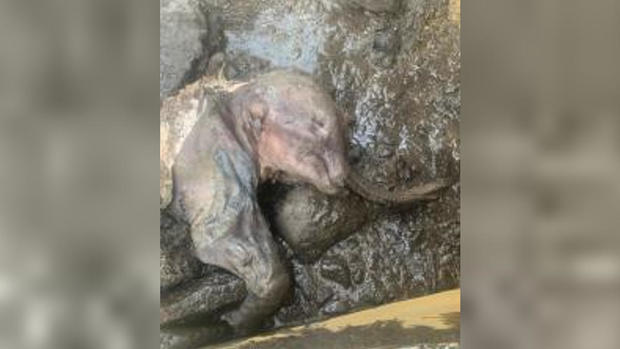Rare mummified baby woolly mammoth with skin and hair found in Canada
A gold miner in Canada discovered a near complete mummified baby woolly mammoth Tuesday, according to the Yukon government and Trʼondëk Hwëchʼin, a local traditional territory. The female baby was named Nun cho ga, which means "big baby animal" in the Hän language.
The miner found the baby, which retained its skin and hair, while excavating through the permafrost at Eureka Creek in the Klondike gold fields within Trʼondëk Hwëchʼin Traditional Territory, the government's press release said. She's estimated to have frozen during the Ice Age, over 30,000 years ago. While alive, she likely roamed the Yukon with wild horses, cave lions and giant steppe bison.
It added that the discovery was "significant" and rare, even for an area like Yukon, which has "a world-renowned fossil record of ice age animals."
"The discovery of Nun cho ga marks the first near complete and best-preserved mummified woolly mammoth found in North America," the press release said.
"It's amazing," Tr'ondëk Hwëch'in Elder Peggy Kormendy in a statement. "It took my breath away when they removed the tarp. We must all treat it with respect. When that happens, it is going to be powerful and we will heal. We must as a people."
Other similar finds have been made in Alaska, where a partial mammoth calf named Effie was discovered in 1948. And in 2007, a 42,000-year-old infant mummy woolly mammoth named Lyuba was found in Siberia. Nun cho ga is about the same size as Lyuba, the press release said.
Trʼondëk Hwëchʼin and the Yukon government are working together to "respectfully preserve and learn more about Nun cho ga," the press release said.
"As an ice age paleontologist, it has been one of my life long dreams to come face to face with a real woolly mammoth," Yukon paleontologist Dr. Grant Zazula said. "That dream came true today. Nun cho ga is beautiful and one of the most incredible mummified ice age animals ever discovered in the world. I am excited to get to know her more."






